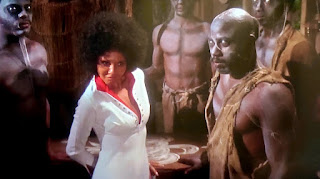(1973)
Overall: MEH
One of the seminal pornographic films from the Golden Age along with Behind the Green Door and writer/director Gerard Damiano's own Deep Throat, The Devil in Miss Jones boasts legit production values and a surreal presentation that elevates it amongst the vast majority of its peers. A hardcore retelling of French philosopher Jean-Paul Sartre's 1944 play No Exit, it concerns a "pure" woman who commits suicide and is therefor denied an afterlife in heaven, though a seemingly understanding angel grants her enough time to "earn her place in hell" by returning to earth as an embodiment of lust; a sinful emotion which she denied herself in life. The story provides enough of a blueprint for a large series of elongated sex scenes, most of which are punctuated by both Georgina Spelvin's matter-of-fact dirty talk and a flowing musical score by Alden Shuman. Though the lewd set pieces steer clear of being distractingly avant-garde, (save for a bit with a snake and an apple, because The Bible), the film still exudes a lurid, arthouse melancholy and Spelvin turns in a performances that seems oddly more sincere than most adult actors were either allowed or able to deliver.
For his follow-up to the landmark The Devil in Miss Jones, pornographic filmmaker Gerard Damiano switched to a type of simmering psychological thriller terrain with Memories Within Miss Aggie. More like an unassuming arthouse drama with a handful of hardcore sex scenes sprinkled around than anything that can fairly be called "horror", it can still loosely be boiled down to an adult version of Misery, with the lonely title spinster regaling her captive companion with tales, (or memories), from her younger and more sexually promiscuous days. Aggie is played by four different actors, which throws doubt onto the character's recollection of her past exploits since her physical appearance in each flashback clashes with not only each other, but with the present, frail, and middle-aged look of Deborah Ashira. The film muses over how both the need for companionship and one's remembrances of a happier time, (whether fraudulent or accurate), each compliment each other as the years go by and isolation overcomes one's emotional grasp of reality. The closing minutes finally deliver some gruesomeness and show how fully unstable our protagonist really is, but the crawl to get there is just that; a crawl.
(1974)
Overall: WOOF
A rare work in straight-ahead horror from porno chic director Gerard Damiano, Legacy of Satan is a forgettable occult exploit where people have conversations about the existence of good and evil, hippies in robes praise the Great Deceiver, and loud 70s decor dominates scenes of a married couple having domestic squabbles with each other. Shot in 1972 and originally conceived as another pornographic movie, Damiano decided to switch gears early on to make it conventionally, utilizing a slew of unprofessional, (and not good), actors as well as a piss-pour budget that makes for a tacky and amateur-hour final product. As far as those performances go, the cast of poorly-recorded non-actors fumble their lines and come off as wooden half of the time and melodramatically ridiculous the other half of the time, especially where the cult members are concerned who mug their way through exaggerated hand gestures and speak their cartoonishly blasphemous platitudes in pretentious accents. The synthy musical score is overbearing and obnoxious, dating the film even further along with the wardrobes, aforementioned room design, and its occult subject matter. Damiano stages a couple of trippy visuals here or there, but even at only seventy-minutes long, it is a lazy and pathetic bore.









































